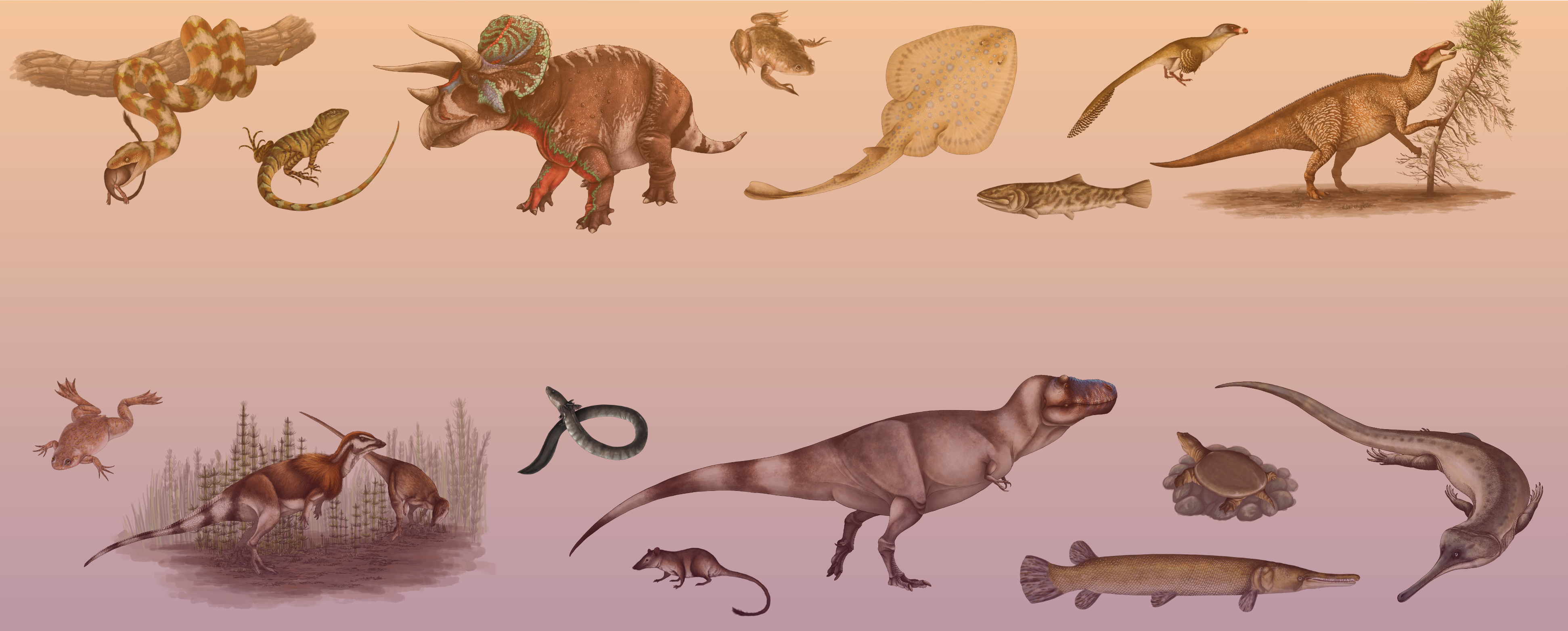
Cretaceous Creatures is a new public science project that offers 8th grade science teachers and students across North Carolina and beyond with the opportunity to make their own microfossil discoveries. Thanks to Bank of America, our Dueling Dinosaurs Worldwide Education Sponsor, eligible classrooms can directly contribute to the science of paleontology.
About The Cretaceous Creatures Project
66 million years ago an asteroid slammed into Earth causing one of our planet’s sixth mass extinction events. This event led to the extinction of nearly 75% of the world’s plant and animal species. The most famous casualties were the non-avian dinosaurs, the group of dinosaurs including T.rex and Triceratops. However, the catastrophic impact goes far beyond the dinosaur’s demise. In a geologic instant, the end-Cretaceous mass extinction event pushed all forms of life in new evolutionary directions, including plants, fish, frogs, salamanders, lizards, turtles, crocodiles, mammals, and even those dinosaurs that did go on to survive the impact–the birds. These species faced new obstacles as well as new opportunities to eventually evolve and flourish. By identifying the species that lived and those that died off, scientists can learn important lessons about how animals respond to environmental disturbances and climate change. We need these lessons to better predict how these same planetary changes will affect our own future. The Cretaceous Creatures public science project is dedicated to investigating this unique event and we invite students to directly contribute to this research effort.
How Can I Participate?
By participating in the Cretaceous Creatures project you will get to contribute real data on the types of species that lived in North America 66-67 million years ago during the Late Cretaceous Period and alongside T. rex and Triceratops. Eligible teachers who enroll will receive access to online lessons and microfossil material to use in their own classrooms. Students contribute by searching through 66-67-million-year-old sediment to discover and identify tiny vertebrate fossils (microfossils) that no one has seen before and send this data to the North Carolina Museum of Natural Sciences’ paleontologists to enter into a research database. Using this database, paleontologists around the world will be able to better understand how ancient ecosystems recovered immediately after the asteroid impact that led to the end-Cretaceous mass extinction event and the end of non-avian dinosaurs.
Where Did This Sediment Come From?
Sediment for the Cretaceous Creatures Project has been collected especially for you by our team of scientists from the world famous Hell Creek Formation in Montana, USA. Specifically, this sediment was collected from rocks nearby where the spectacular Dueling Dinosaurs specimen was discovered. The Hell Creek Formation captures what life was like in the region when the asteroid hit and these particular fossils represent the animals that lived, and died, around the same time as the Dueling Dinosaurs themselves. Today, the landscape of the Hell Creek Formation is mostly badlands characterized by dry terrain, steep hillsides, deep valleys, soft sands and clay, and minimal vegetation. But, back in the Late Cretaceous (66-67 million years ago) it was a swampy coastal plain full of wildlife including predatory dinosaurs such as Tyrannosaurus and Acheroraptor, herbivorous dinosaurs like Triceratops and Edmontosaurus, and many other animals including frogs, turtles, fish, crocodilians, and small mammals.
What Are Vertebrate Microfossils Anyway?
Vertebrate microfossils are tiny fossils best viewed under a hand magnifying lens or microscope. They represent the remains of small animals from ancient ecosystems and are often concentrated in what scientists call “vertebrate microfossil bonebeds.” These concentrations are thought to form in areas that were once home to wetlands, lakes, and ponds. Although the fossils are small, vertebrate microfossil bonebeds are an important source of data for understanding ancient ecosystems and environments. This is because these microsites contain large sample sizes of small bones, teeth, scales, and shells of the animals that once lived there. The ancient creatures and tiny fossils they leave behind give us a ‘snapshot’ into a relatively small area over a fairly short period of geological time. When paleontologists spot these sites during fieldwork, they collect the material by shoveling hundreds of pounds of sediment into dozens of bags to be sent back to the lab. At the lab, paleontologists wash the sediment through a series of different sieves to separate the material of interest from the rock so they can better collect the tiny fossils within.
Searching for and identifying tiny fossils is a big job that gets done a lot faster with many hands! And you can help!
Header text
Why Join
For the Education, Experience, and Impact
Free 2-Day Lesson Plan
Slides, Notes, and Videos
Online Interactive Modules
Actual Fossil Material
Members of the public are invaluable to the research process. They help collect data, produce knowledge, and make scientific discoveries that inform our understanding of the world. The fossil data that students collect in this project will be used to build an original scientific database for paleontologists across the world to further study and understand the organisms and ecosystems that lived just before the end-Cretaceous mass extinction.
Who Can Join
National Participants
8th-grade science teachers at public, private, or charter schools in the United States
North Carolina Participants
8th-grade science teachers at public, private, or charter schools in North Carolina
Our goal is to reach at least 1 school in all 100 counties in the state, and we are especially interested in partnering with teachers in the following counties: Alleghany, Anson, Ashe, Beaufort, Bertie, Bladen, Brunswick, Camden, Caswell, Catawba, Chatham, Cherokee, Chowan, Clay, Cleveland, Columbus, Currituck, Gates, Graham, Granville, Greene, Halifax, Harnett, Hoke, Jones, Lee, Martin, Montgomery, Nash, Northampton, Onslow, Pamlico, Swain, Tyrrell, Vance, Warren, Washington, and Wilson.
How To Join
Decide on the approximate date you want to implement this 2-day project in your classroom
Enroll at least 4 weeks in advance of this date so your kit can be delivered to you in time
Fall 2024-Spring 2025 registration is closed
Fall 2025-Spring 2026 registration will open in July

